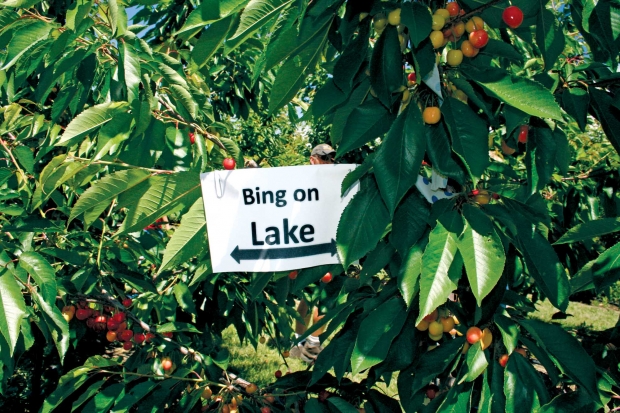
In a trial at WSU, Prosser, with Bing as the scion, MSU rootstocks have produced trees similar in size to trees on Gisela 5. (Geraldine Warner/Good Fruit Grower)
Dr. Amy Iezzoni, cherry breeder at Michigan State University, has developed five new dwarfing and precocious sweet cherry rootstocks that nurseries are now propagating.
Before the rootstocks go into commercial production, Iezzoni plans to put them in further trials to find out how they perform with cherry varieties of different cropping potential and to assess what the most suitable training systems, soils, and growing conditions might be.
The five rootstocks, Clinton, Cass, Clare, Lake, and Crawford, are named after Michigan counties.
Cherry rootstocks that induce early cropping and reduce tree size can enhance profitability, Iezzoni points out. Early cropping can ensure an early return on investment, while abundant bloom can increase the likelihood of setting a crop each year. Small tree size can reduce labor needs.
In a current trial at WSU, Prosser, with Bing as the scion, the rootstocks have produced trees similar in size to those on the Gisela 5 rootstock, with the exception of Clare, which produces trees significantly smaller than G.5.
Tissue culture
In the third leaf of the trial, all rootstocks produced more bloom than G.5 or G.6. However, fruit size was comparable, suggesting that trees on the MSU rootstocks can produce large fruit, given the proper training system to manage tree vigor and appropriate crop load adjustments.
The rootstocks have been virus-certified by the Clean Plant Center Northwest and put through genetic testing to confirm their identity. In 2011, Cass, Clare, Clinton, and Lake were distributed to seven nurseries in Washington, California, and Oregon, to give the nurseries experience in propagating the rootstocks and to generate a supply of rootstocks for further testing. Tissue culture appears to be the most efficient way to propagate them. Iezzoni reported these findings recently to the Washington Tree Fruit Research Commission, which has funded her work.
The fifth rootstock, Crawford, was not initially selected for further testing because it showed signs of graft incompatibility with Hedelfingen, the scion in the original plot at MSU’s Clarksville Experiment Station. However, it has performed well in the Prosser trial with Bing as the scion, and was provisionally released to nurseries this year, with full release expected in 2014.
New trials
Clinton and Crawford appear to induce wide branch angles and a flat growth habit, which makes them suited to a Vogel Central Leader training system, while the other three rootstocks have a more upright growth habit that would be a plus in an Upright Fruiting Offshoots (UFO) training system, Iezzoni explained during the commission’s cherry research review. In the Prosser trial they are trained to a three-leader system.
Iezzoni is proposing to remove the Prosser planting after the 2014 season and plant three experimental plots in 2015 in The Dalles, Oregon; Wenatchee, Washington; and Prosser.
The new trials will include Cass, Clare, Clinton, and Lake along with three controls (G.5, G.6, and a Krymsk rootstock). The scions will be Regina, Early Robin, and Sweetheart. In Oregon, the trees will be trained to the Vogel Central Leader, which is well suited to pendant, nonspur-type varieties such as Regina. In Prosser, the UFO system, in which trees are trained with upright unbranched limbs, will be used. In Wenatchee, trees will be trained to the Super Slender Axe, developed by Dr. Stefano Musacchi. In this system, fruit is produced from basal flower buds on the previous season’s shoots, eliminating the problem of small fruit associated with high production.
The fifth rootstock, Crawford, will be planted in trials in 2016, along with Clinton and control rootstocks.
Working with Iezzoni on the new three-year project are: Dr. Matt Whiting, WSU cherry horticulturist in Prosser; Dr. Desmond Layne, WSU tree fruit extension leader; Lynn Long, Oregon State University extension educator; and Tom Auvil, research horticulturist with the Washington Tree Fruit Research Commission.
Horticulturists Dr. Todd Einhorn at OSU and Dr. Stefano Musacchi at WSU, and The Dalles grower Tim Dahle are cooperators.
“Having collaborators on the project who can evaluate the horticultural aspects is going to be the key to the project,” Iezonni said. “If you overcrop these, you can shut down tree growth.”
A new approach
Long said the dwarfing rootstocks bring a new approach to cherry production because growers can consistently grow high tonnage. “But it also means you’re going to have to take the time, effort, and labor to thin these in some way, either by chemicals or hand thinning, and how the economics of that play out is not clear.
“But it’s a completely different approach than how we’ve grown cherries in the past, and I think it’s worth looking at,” he added.
Asked if the rootstocks are hardy enough to survive Pacific Northwest winters, Iezzoni said when she first started the breeding project in Michigan, one of her strategies was to try to kill the rootstocks. The rootstocks that made the cut survived everything.
“I would not anticipate a problem with cold hardiness or pseudomonas,” she said. •






How can I get some of these new rootstock, specifically the really dwarf ones?